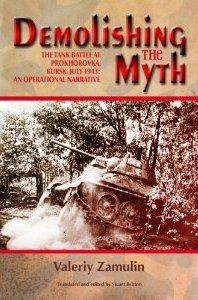Demolishing the Myth, The Tank Battle at Prokhorovka Kursk, July 1943

For armor enthusiasts few battles rank as high in terms of interest as the one fought in July of 1943 near the small Russian town of Prokhorovka; a struggle occurring during the Wehrmacht's summer offensive against the Soviet held Kursk bulge in German lines. In spite of this interest however, a considerable amount of misunderstanding continues to cloud the events that brought Nazi Germany's last great offensive in Eastern Europe to a close.
Nevertheless, in Demolishing the Myth: The Tank Battle at Prokhorovka, Kursk, July 1943: An Operational Narrative Valeriy Zamulin has painstakingly researched and investigated a wealth of primary sources to produce perhaps the most accurate look yet at why and how the German offensive failed to meet its objectives. In particular, Zamulin has examined and, in tremendous detail, presented the crucial events occurring between July 4th and the 17th on the southern facing of the Kursk Bulge - where the Red Army's Voronezh and Steppe Front's defeated the best efforts of Germany's Army Group South to meet Operation Citadel's primary or secondary goals.
The core of Zamulin's analysis focuses upon combat operations from July 10 - 17, according to Zamulin the period of time defining the battle for Prokhorovka, and one going well beyond the traditional narrative focusing only upon events that had occurred on July 12th - when the Soviet 5th Guards Tank Army and 5th Guards Army hammered into Germany's II SS Panzer Corps. By recasting the struggle centered on Prokhorovka in such a way, Zamulin places the fighting into its proper context vis a vis the larger campaign of which it was the central part. This has the added benefit of providing the reader with a more holistic look at how in reality a series of interconnected decisions and battles ultimately decided Citadel's fate - rather than just the July 12th combat near Prokhorovka itself. In and of itself this represents a monumental achievement, as reconstructing such a narrative involved researching actions taken and decisions made by a whole host of leaders on each side of the lines; as well as the placement and movement of a dizzying array of army's, operational groups, corps, even down to the smallest tactical units.
Even though going well beyond just looking at events on July 12th near Prokhorovka this work is undoubtedly one whose bulk is devoted to a study of the II SS Panzer Corps attack into the Voronezh Front's deeply echeloned defenses and the Red Army's response to this attack. Zamulin, a former Deputy Director and Director of Research at the Prokhorovka Battlefield Park Museum, writes from the unique perspective provided by not only the fact he spent the bulk of his life living where this epic clash took place, and his access to important records of the struggle, but also a lifetime spent researching the fighting near Kursk. All of which informs and backs a study that among other things; deconstructs German objectives, how they were to be achieved, weighs the Soviet response, reveals in tremendous detail how the plans of the opposing army's fared once battle was joined, answers questions that have long eluded past scholars, including one's as basic as how many armored fighting vehicles clashed on the respective battlefields, and in that process brings much needed clarity to a moment in history long since obscured by decades old myths and misperceptions. Furthermore, backing what is undoubtedly a thoroughly researched book the reader is amply rewarded with a plethora of tables, maps, pictures, including current pictures of the Prokhorovka battlefield, and appendices detailing; German and Soviet comparative strengths, tables of organization and equipment, losses sustained by each side, and more. Finally, the book approaches the topic as a true operational history also featuring detailed first person accounts and studiously examining lessons learned; all while providing balanced and well reasoned insight helping the reader to understand how and why events unfolded as they did.
The book is organized into eighteen easily digestible chapters and proves an absorbing read, even for those who consider themselves otherwise well informed on the topic. As such, this reviewer does not hesitate to recommend for this website's readers Demolishing the Myth: The Tank Battle at Prokhorovka, Kursk, July 1943: An Operational Narrative.
1.Steven Douglas Mercatante's Why Germany Nearly Won, A New History of the Second World War in Europe, will be published early in 2012. Why Germany Nearly Won not only explores how close Germany actually came to winning the Second World War, but also why Germany very nearly cemented a position of hegemony over the entire European continent by doing that which many consider to be its fatal decision; invading the Soviet Union in the summer of 1941. This work stems from over two decades researching and studying the Second World War. Steven's writing in the historical field goes beyond his research and draws upon his experience as a former history teacher, from his undergraduate studies in history at the University of Michigan, from his graduate work in history at Eastern Michigan University and from his study of International Law, including the laws of war, at Michigan State University College of Law. Steven has been published numerous times over in the historical field, both online and in a scholarly journal with an article entitled; The Deregulation of Usury Ceilings, Rise of Easy Credit, and Increasing Consumer Debt, published in volume 53 of the South Dakota Law Review.



Post new comment